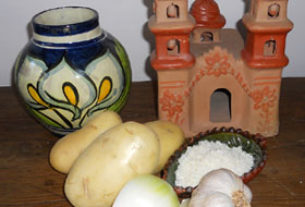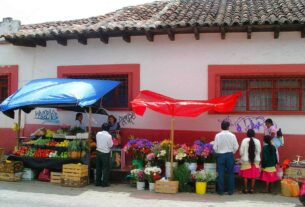Now that you’ve decided to visit Tuxtla Gutierrex, let me give you some information about the climate here and what type of clothing you will need to pack for your visit.
The city of Tuxtla Gutierrez fills a long, low valley and is usually described in guide books as being terribly hot and humid. In fact, the climate is really quite comfortable. For those of us who have endured long hot summers in such places as Houston or New York City the temperatures here are moderate. There is not much difference between the wet and dry seasons other than the rain itself. Mornings are cool enough year round to require blankets. Fans and open windows are used in lieu of air conditioning; and most houses, offices, stores, and restaurants open directly onto the streets and patios.
Some afternoons do get hot for a couple of hours. This is a good time to stay inside for a traditional siesta or to sit in the shade of one of the many tree-filled parks. Most businesses here still close from 2:00 p.m. until 4:30 or 5:00. Locals usually keep a bottle of cold purified water handy in the afternoons, whatever they are doing.
But the heat lasts only a short time. Not like Houston, where it can reach 107 degrees every afternoon for weeks and never drop below 85 at the coolest part of the day. By the time you are ready to eat a light cena or a late dinner, the night air will again be fresh and comfortable.
So pack accordingly. Women here wear strappy sandals with everything and no stockings. Treat yourself to a pedicure before you come! Also because it does rain much of the year, and because neither taxis nor colectivos have air conditioning, hair-dos should be kept simple. Either very short or long enough to pull up into a ponytail or twist into place with a colorful clip. No carefully constructed sets sprayed into place, please.
Older women wear skirts and blouses or dresses. Special favorites, appropriate everywhere you go, are long slip-dresses with spaghetti straps. You don’t even have to be thin to wear them! And they work with a shawl for nights out on the town.
Younger women–or those who are in good shape at any age– can wear tight jeans with a sleeveless top and high-heeled sandals. Please don’t bring shorts. They will only offend the locals wherever you go.
And how should the gentlemen pack? Also no shorts, please. Otherwise, Tuxtla Gutierrez is a very casual town by US standards. The older men wear traditional embroidered shirts with dress slacks and either heavy sandals without socks or leather shoes such as loafers. Young men wear short-sleeved plaid shirts tucked into jeans or slacks. They, too, wear sandals or loafers. Only occasionally do the men here wear tennis shoes except for sports activities. Shorts are only seen on joggers, soccer players, and European tourists.
Nor will you see men wearing business suits. Cell phones, beepers, and manila folders mark the local with serious business interests. Both men and women should leave their valuable jewelry at home. Chiapanecos themselves are very cautious about flaunting their wealth on the streets of Tuxtla.
So, how are you getting here? Will you be driving, or coming by bus, or will you fly?
If you are accustomed to driving in Mexico and are familiar with the “rules of the road”, the highways–though quite mountainous when coming into Tuxtla from any direction–are in good condition and will not bother the experienced driver. Hotels and restaurants have safe parking areas, usually with an attendant who will wash your car while you sleep or dine.
There are numerous military check points around the perimeter of the capital city. The soldiers will be very polite but also very thorough as they search your vehicle. They are looking for drugs, weapons, illegal aliens, and stolen auto parts. Keep your passport and tourist visa handy and you should have no problems.
There are two airports which serve our area. One about 28 kms west of town is rarely used. Most flights come into the airport just southwest of the city in the colonia of Teran. It can be reached quickly and easily by taxi. When you arrive, however, you will be required to use a special airport taxi into town. It will cost much more than the local ones. Be prepared for inflated prices in this one instance, but don’t expect such exorbitant prices elsewhere during your stay in Tuxtla.
First-class buses which serve Tuxtla Gutierrez are Cristobal Colon, Maya de Oro, and ADO. A good second-class bus line, Rapidos del Sur, also serves this part of Mexico if you are traveling on a budget and don’t mind not having air conditioning.
All these bus lines leave from the TAPO station in Mexico City at frequent intervals. The time from there to Tuxtla is about 15 hours.
Because the bus terminal here is quite small and unintimidating, you will have no trouble getting your luggage, making a call from the pay phones (cards only, no coins), buying onward tickets, finding out about schedules, or catching a taxi. The terminal is about three blocks west of the plaza, usually called Parque Central by the locals.
Although it is the central square in town, next to the cathedral and surrounded on the other sides by government buildings, no one refers to it as the zócalo. So if you say “al zócalo, por favor” to a cab driver, he will look at you with blank incomprehension.
When you reach Tuxtla–whether by bus, by plane, or by car– you will have your choice of nice hotels in many price ranges. There are several very upscale ones on the main boulevard, Dr. Belisario Dominquez, near the universities on the west side of town. The one which looks most like something out of a Hollywood movie is El Camino Real, a splendid building set on a high hill from which fountains gush water toward the boulevard below. The lobby is open-air with more fountains, swimming pools, colorful birds, flying free, bars and restaurants, dense tropical flora, and ever attentive valets and waiters ready to fulfill your every desire. I suggest calling ahead for reservations if you intend to stay here. (A room for two is 970 pesos per night.)
Other upscale, but not quite so glamorous, hotels are the Hotel Flamboyant (730 pesos per night), and Hotel Arecas, (495 pesos), both near the university and the large modern shopping mall Plaza Cristal. Directly across the boulevard from El Camino Real is a comfortable motel, Maya Sol. (460 pesos per night) This motel is near the city’s best park for jogging and offers a swimming pool surrounded by an outdoor restaurant. There is a breakfast buffet every morning and a disco at night. It also accommodates those who are not guests but wish to use the pool. For 20 pesos you can swim all day and into the evening.
Closer in towards the center of town, near the tourist bureau, is Hotel Bonampak (495 pesos per night). It is a collection of hotel rooms, several great restaurants, a travel agency, and a casa de cambio. Also nearby are branches of several major banks, an ice cream shop, a swim suit store, a fabulous pastry shop, and a great newsstand, Entretente, which sells some magazines in English in addition to a good assortment of local newspapers and paperback books in Spanish.
On the Libramiento Sur, the southern section of the 4-lane traffic loop around Tuxtla, is the Hotel Costa Zu Turquesa. This hotel features a panoramic view of the city in addition to its fine restaurants, bar, and elegant garden suites (350 pesos).
As in all Mexican towns, there are also many small family-run hotels which are clean, convenient to the centro, safe, and comfortable. The owners probably live on premises and will see to it that you feel like royalty as you visit their “home”. If this is the kind of accommodation you are accustomed to in Mexico–and we certainly are in our family–you already know to simply walk around until you find a place that interests you, ask to see the rooms available, and pay cash when you like something. There are usually discounts for those who pay by the week, in advance.
Tuxtla Gutierrez is an exceptionally affordable place to visit, even compared to other cities in Mexico. This is in part because it is not a tourist destination. This is also in part because the state of Chiapas, while rich in natural resources and friendly people, is not wealthy in terms of pesos.
It also means the people here speak very little English. If you do not feel comfortable with your Spanish and think you will need an interpreter to fully enjoy your visit, e-mail me and I will contact a chiapaneco who is completely bilingual who will be available to assist you.
Now, you are ready to spend three wonderful days enjoying a little of what Tuxtla Gutierrez has to offer.
Come on down! Bienvenidos to Tuxtla!
- TO BE CONTINUED


